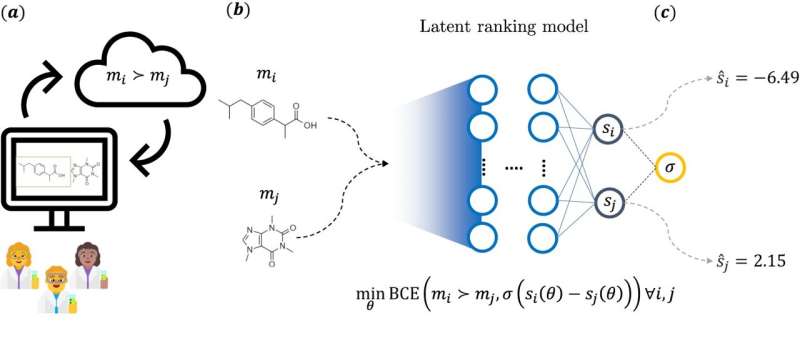November 7, 2023 report
This article has been reviewed according to Science X's editorial process and policies. Editors have highlighted the following attributes while ensuring the content's credibility:
fact-checked
peer-reviewed publication
trusted source
proofread
Teaching AI systems to use intuition to find new medicines

A combined team of biomedical researchers from Novartis Institutes for Biomedical Research and Microsoft Research AI4Science has made inroads into teaching AI systems how to find new medicines. In their study, reported in the journal Nature Communications, the group used feedback from chemists in the field to provide intuition guidelines for an AI model.
Finding new medicines is a notoriously difficult and laborious task. The process for finding new therapies typically involves experts in a variety of fields working on different parts of the problem. Doctors and other medical researchers, for example, must first uncover the roots of a given illness to find its cause. Chemists or other medical researchers must then find a chemical that might reverse the problem or stop it from happening in the first place.
Both parts of the process take time and effort. In this new project, the research team sought to determine whether AI applications might make the second part easier.
One of the ways that new drugs are found is through intuition—a gut feeling by a chemist that certain chemicals might prove useful for treating certain ailments. This intuition is difficult to code. That might change now with the advent of AI applications.
To apply AI to the problem of drug development, the researchers asked for feedback from 45 chemists whose job it is to find new medicinal drugs. Each was asked to choose from a list of 220 chemical pairs they thought had a good chance of becoming a useful drug using nothing but intuition gained from years of experience in the field.
That feedback was then given to the AI system, which ranked chemical pairs based on what it had learned—it responded by giving each pair a score based on its estimations of the likelihood that the drug would be useful. The research team then sent the highest-scoring chemical pairs to an AI-based system that designs molecules based on chemicals it is given—some of the results from the system were described by the researchers as promising.
The research team then tested their system on drugs already on the market and found what they describe as a "signal" to be learned from chemist-based intuition data—a finding that has convinced them that further research is warranted.
More information: Oh-Hyeon Choung et al, Extracting medicinal chemistry intuition via preference machine learning, Nature Communications (2023). DOI: 10.1038/s41467-023-42242-1
Journal information: Nature Communications
© 2023 Science X Network





















